Name
Мінск (Minsk). This is the Belarusian spelling - the Russian spelling is Минск (pronunciation is similar). Centuries ago, the town was also known as Menesk (also: Mensk). There are several theories about the origin of the name - maybe it was the name of the founder, maybe it derives from the Russian word менять (men'yat'), which means "to exchange". The town has always been an important trading place. It was during the Polish reign that Mensk finally turned into the presently used name 'Minsk'.
Location

| ||
| Minsk |
Minsk is the capital of the →Belarus (White Russia) and is quite centrally located. Only →Vilnius in the north-west is only 185 km away and therefore rather close. Geographically (and also geopolitically), Minsk lies halfway between Moscow and Berlin, but it's substantially closer to the former. The area around Minsk is dominated by the Belarusian Alps (don't take that literally - it's my personal exaggeration) with hills exceeding 300 m in height. The town itself straddles the small river Свислочь (Svislotch) . Some 10 km north-west of the centre of Minsk, there is the 8 km long and 4 km wide Sasslavl water reservoir. The town itself is encircled by the orbital motorway M 9.
Population
Minsk had not less than 1.729 million inhabitants in 2004, making it the by far largest city in the Belarus. In other words - every 6th Belarusian lives in Minsk. The town forms its own administrative unit.
Orientation

| ||
| Typical vista: broad boulevards and some drabness |
Minsk stretches along the small river and occupies some hills on both banks, making it topographically an interesting town. The Belarusian name of the train station is Чыгуначны вакзал (Tchyigunatchnyi vaksal), but this name never appears on timetables (look for the old name Минск - Пас). The train station is conveniently located some hundred metres south of the centre (although a 'typical' centre is hard to define). Next to the train station is the central bus terminal. The main road of Minsk is not far from there and known as the просп. Франціска Скарыны (Skaryina-Prospekt). Many of the main attractions of Minsk line up along this broad street. Not far from the main road, on the other side of the river, lies a small quarter trying to resemble the Old Minsk as it existed before WW 2.
To cut a long story short - Minsk is not really attractive and offers very few highlights. But I have to admit that my opinion might be biased by the fact that I've visited Minsk in November (dark, foggy, temperatures around 0 C, drizzle or sleet), making the town an extremely drab place. Things might look better in summer. Anyway, Minsk is a prime example for stalinist-socialist urban development in a dimension that cannot even be experienced in Moscow or other towns in Eastern Europe. Most visitors will soon be weary of the place (especially when seen many other places like that before). City maps (plan goroda) are sold everywhere for less than 1 Euro, but all of them seem to be in Russian (ie neither in Belarusian nor in English), which might be confusing from time to time, since some street signs are in Belarusian only.
History
The town was first mentioned in the year 1067 in connection with - the complete destruction of the town! At that time, Minsk was within the sphere of innfluence of the Kievan Rus. And it was not the last time that Minsk was leveled. Historians estimate that the town was all in all destroyed ten times or more in its long history. During the 14th century, Minsk became a part of the →Grand Duchy of Lithuania. Since Minsk marked the crossing point of several trading routes, it soon developed into a very important market place with far-ranging connections. Prosperity was only interrupted in 1505 when the Tartars invaded and burnt down the town (see also →History of the Crimean Tartars).
Another desaster struck the town during the 17th century. The town was completely destroyed again during the Russo-Polish war from 1654 to 1667. Since 1793, Minsk was ruled by imperial Russia. Ever since, the town lost a good deal of its importance. The next to invade Minsk was Napoleon, who looted and burnt down the whole town in 1812. During the second half of the 19th century, industrialisation reached Minsk. The opening of the railway connection to →Brest and Moscow in 1900 positively influenced the development of the town. However, at that time less than 100,000 people lived in Minsk - more than half of them were Jews.
The 20th century was a very tumultuous one for Minsk. During the First World War and the October Revolution, the town changed hands quickly - Germans, Polish, Bolsheviki and Mensheviki took the town alternately. The Bolsheviki finally took over and declared Minsk the capital of the Belarusian SSR. Since 1922, the Belarus SSR officially belonged to the Soviet Union. This initiated an economic boom, which was only brought to a halt by Nazi Germany in 1941. Massive air raids and the Minsk battle of encirclement and annihilation at the beginning of the invasion, almost entirely crushing the the Soviet tank brigades, almost entirely wiped out the town. Within the following three years, an estimated 400,000 inhabitants were killed - most of them were Jews.
The town was eventually liberated on July 3 in 1944. Even today, this day is celebrated throughout the Belarus as Independence Day. The following years were spent to methodically rebuilt the town. As a matter of fact, a completely new town was built. Ruthless industrialisation came along with the reconstruction. Since 1984, the very useful subway serves the citizens. Since 1991, Minsk is the capital in all respects of the Belarus and also, which is a little known fact, the seat of the headquarters of the Commonwealth of Independent States.
Minsk is trying hard to improve its appearance. On the occasion of the 930th anniversary in 1997, many streets and buildings received a massive facelift. However, it is not to be expected that Minsk is going to be declared world heritage site by the UNESCO in the near future (I guess it's the Germans who should be blamed).
Getting there / transportation
Minsk is an important stop along the well-frequented international Moscow-Berlin railroad, which means that it has excellent train connections. All long-distance trains leave from the above-mentioned main train station. Busses to destinations inside and outside the Belarus leave from the adjacent bus terminal. For detailed information on how to get to the Belarus and Minsk respectively see →Belarus: Getting there.
Minsk has two airports - Minsk 1 and Minsk 2. The latter is more important for international flights and lies some 40 km away from the town. Minsk 1 is almost in the centre of town.
The town has a very effective transportation system with trolley buses, buses and the subway. Tickets are the same. A single ride costs 360 BYR (0.13 Euro). Note that tickets for the bus and trolley bus must be purchased in advance and then punched on the bus. In metro stations, small plastic chips must be bought in advance to get through the gates. It's okay to change the subway lines without getting a new chip - well, there are only two lines.
Alas, this town is partially an Orwell-like nightmare. A giant concrete ghetto without character. Places like these can be found all over Eastern Europe (well, not only there) but Minsk has another dimension (see population). The appearance is due to the Wehrmacht leveling the town completely, giving way to "total stalinistic urban development". But the word "ghetto" is an exaggaration. Stalinistic urban development has its good aspects, too: There is lots of space, very broad roads and a lot of green. As a matter of fact, Minsk can be fun to live in if you like such places. The town is divided into several large districts (called rayon). Names of the rayons haven't changed: There is the Frunse-, Moscow-, October-, Lenin-, Factory-, Partisan-, 1st May-, Soviet- and Central Rayon.
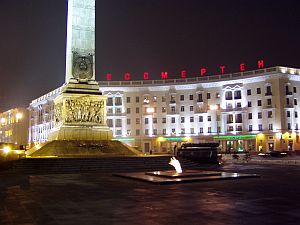
| ||
| At central Victory Square |
As already mentioned above, просп. Франціска Скарыны (Skaryina-Prospekt) is the main arterial road in the centre of town. The road starts from, although it's almost needless to say, пл. Леніна (Lenin Square) not far from the train station and runs dead-straight to the north-east. The prospekt (Russian for boulevard) is many kilometers long and leads to the motorway M 2 direction Smolensk and to the airport Minsk-2. The subway runs along the boulevard, too. When following the road direction north-east, you will first cross a bridge and soon after that find yourself right on пл. Победы (Victory Square) - a giant roundabout, partially flanked by large semicircular lit-up buildings. In the middle stands a monument commemorating the dead of the Great Patriotic War (i.e. WW 2), consisting of an obelisk, an eternal flame, hammer and sickle and the like.
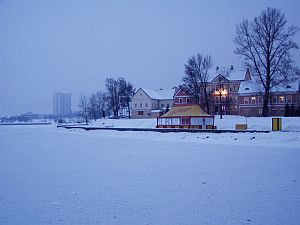
| ||
| View over the river to the Old town |
The area around the bridge of the Skaryina Boulevard spanning the river Svisloch is dominated by several nice parks. When walking from there along the river to the north-west, another large bridge comes into view. Next to the bridge starts the historic old town or at least something that tries to resemble old Minsk. The quarter occupies a rather small stretch along the river bank and is not really attractive, but it still offers a nice escape from the dull surroundings. Among other buildings, there is also a small synagogue in the old town. Next to the old town lies the large пл. Паріжской Коммуны (Paris Commune Square), which is actually a huge park with a somewhat strange and somehow too big theatre in the middle of it.
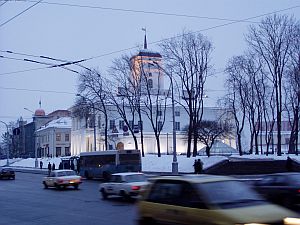
| ||
| The old town hall of Minsk |
On the other side of the river, as seen from the old town, there is a subway station and square named Няміга (Nyamiha), which hit the headlines in 1999 when a large crowd stampeded to the station after torrential rain started suddenly. Some dozen people were killed in this incident. Fromn there it's only a few hundred metres eastwards to пл. Свабоды (Liberty Square). The square marks the place where the old centre of Minsk could be found around the 16th century. Today, not much more than three churches (Duchavski, Bernhardine and St Peter & Paul Church) is left from those glorious old days. And the old, rebuilt town hall. However, the square is also dominated by modern Minsk.
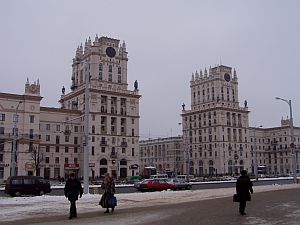
| ||
| Stalinistic classicism at the train station |
The full monty of typical stalinistic architecture can be experienced right after leaving the train station. The Прівакзальная пл. (Station Square) is dominated by a large ensemble of socialist classicism as it can be found in other Eastern European cities, e.g. Moscow, →Ky'iv (Kiev), East Berlin, →Bucharest and so on. The same can be said about вул. Леніна (Lenin street), which stretches north of the train station near the Dynamo Stadium. Lenin str. is the main shopping street of the capital, with countless shops, the obligatory ГУМ (GUM department store) and, of course, a McDonalds.
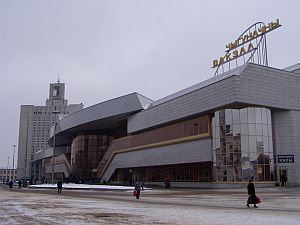
| ||
| The new train station is a stylistic incongruity |
Only very few buildings appear to be different from the dull socialist uniformity. Among those buildings is the futuristic train station, which won't really fit into the surrounding townscape. And it's a fascinating place to see how they desperately try to keep the building nice and tidy. Not easy, since the train station is always packed, with more than a handful of completely drunk people hanging around here and there. The train station features some kiosks, news agents, coin lockers, two banks exchanging money and much more. A large tunnel connects the station with the other side of the boulevard. Another one leads to the metro (subway) station. As already mentioned above, there are two subway lines, with one of them running below the Skaryina prospekt. The tricky thing with the subway is that some stations have been renamed, so the recent station name is often completely different to the name given on city maps.

| ||
| The Minsk subway |
There is more to explore in Minsk - for example dozens of museums, many of them dealing with the heroic struggle against the German aggressors during the Great Patriotic War (WWII), countless monuments - most of them dedicated to the same subject, amazingly dull administration buildings, some nice parks and much more.
It would be an exaggeration to call Minsk a beautiful town. However, seeing the archetypical blueprint of a Soviet ideal town in such a dimension is quite an experience. Yes, that's also Europe. If Minsk would be only a quarter of what it is today, it would be a completely uinteresting place. Just a ride through the vast suburbs - although it's hard to tell where the centre ends and the suburbs start - is something special.
Finding affordable accommodation in Minsk isn't easy. As already mentioned in the →travel tips Belarus section, foreigners have to pay the triple or even quadruple price. There are quite a lot of expensive hotels, but very obviously Minsk is not used to cater foreign tourists, and so only few staff can speak English or another foreign language.
I had done some research on www.inyourpocket.com and decided to give their highly recommended Hotel Zeloni a try, which was supposed to set us back something between 5 and 12 USD. It's in the middle of nowhere, quite away from the centre, in Odoyefskovo 52. However, there we were told that we would have to pay 70 USD for a room! The reception lady was nice, showing mercy and phoning around for us. But wherever she asked - it was at least 50 USD for a room.
As with us, we finally ended up in the slightly dreary Гостиница «Академическая» (Gastinitsa Akademitscheskaja - Hotel of the Academy of Science). A more or less clean double set us back 17 Euro per person - 50 USD for the room so to say. But that was the price for the first night only - after that, it would be 32 USD only. The first night is substantially more expensive because of the registration procedure (the hotel registers guests with the local authorities). The hotel - rather a guesthouse - is conveniently located some 300 m away from the subway station Akademija Navuk. The ground floor houses a Chinese Restaurant, open from 1 pm to 11 pm. More or less authentic main dishes cost around 2 €. The chef is Chinese with a limited selection of ingredients. Staff at the hotel can be gruff in the beginning but they are quite nice and helpful. Hotel address: vulitsa Surganova 7, Tel: (017) 266 2481, Fax: (017) 268 4871.
- www.minsk.gov.by: Official website of Minsk - includes an extensive English version and is quite useful.
- www.privet-minsk.com: Very nice and - more than that - useful private website on Minsk. In English, German and Russian.
Do you have or do you know a good website about Minsk? Don't hesitate, let me know! After checking it, I would love to add it to the link list. You can submit a link by using the →contact form. Note that commercial websites will be treated differently.
©2024 Europe-East.com

 Albania
Albania Belarus
Belarus